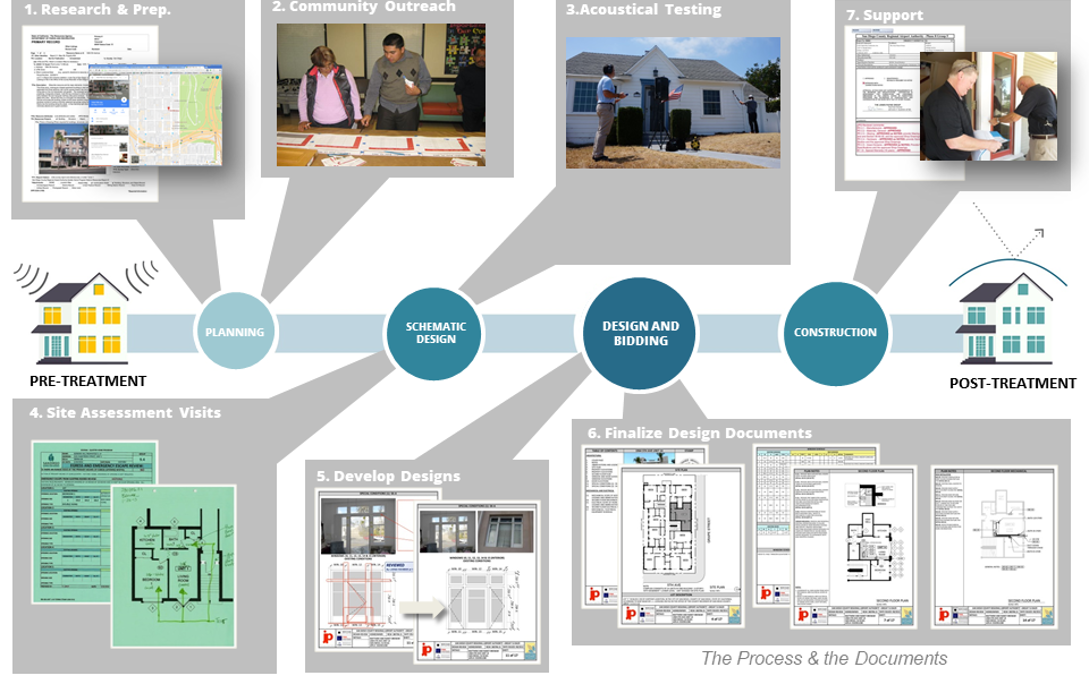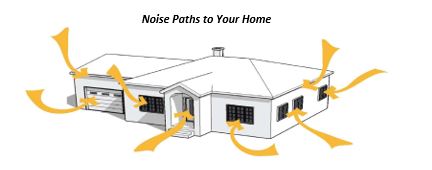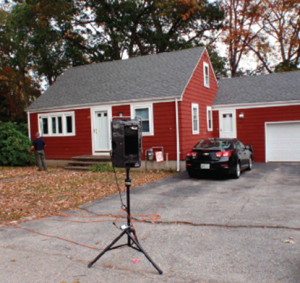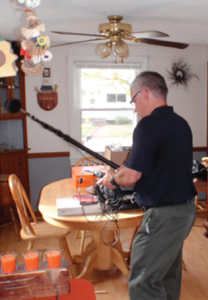THE SOUND INSULATION PROCESS

STEP 1 – Notification of Program Eligibility
Based upon the program guidelines, the Logan RSIP Team will notify you in writing that your home is eligible and has been selected as part of the Program.
STEP 2 – Pre-Construction Acoustical Testing
Using an artificial noise source, acoustical measurements will be taken of exterior and interior noise levels within select homes. This will determine the noise reduction capability of existing walls, ceilings, windows, and door assemblies. These tests take about two hours. This information will be used by the Logan RSIP Team to make decisions about acoustical treatments.
STEP 3 – Assessment Visit (1st Visit)
The Assessment Visit generally lasts two hours. The Logan RSIP Team will document the existing conditions of your home. They will be drawing floor plans, taking pictures, measuring your windows and doors, identifying wall, and ceiling types, and noting general conditions. It is important that the team have access to all rooms as well as mechanical and electrical systems.
Preliminary treatment recommendations will be made at this visit. Door styles and window color options will be presented to you, and you will be asked to choose your preference, in the event these items are replaced. All treatment recommendations are subject to review by the Massport and the FAA.
STEP 4 – Property Owner Agreement
A member of the Logan RSIP Team will meet with you at your home to discuss specific treatment recommendations that have been made for your home. The document will contain a written scope of work with accompanying drawings and photos to illustrate the treatments. The team member will explain to you in detail the treatments that are proposed. At the end of this visit, you will have an understanding of the scope of work for your home.
The Property Owner Participation Agreement defines certain obligations on your part, including:
- Providing access to the contractor during construction.
- Being present (or having an authorized representative present) during construction.
- Moving furnishings and window dressings to allow for the work to proceed.
- Correcting deficiencies that may prevent the treatments from being installed.
In exchange for the soundproofing improvements in your home, the Logan RSIP will require a signed and notarized contract between you and Massport. You will find a copy of the Agreement in the Resources tab of this website. This appointment will normally last one hour.
STEP 5 – Contractor Selection
Once you have approved the proposed treatments, the Logan RSIP Team will prepare documents for the contractors. Your home will be part of a construction project that will include other homes in the treatment area. After Massport receives and evaluates all bids, the contractor submitting the lowest responsive and responsible bid will be selected for all improvements for this construction project.
STEP 6 – Pre Construction Walk-Through
Once the contractor has been selected the contractor will schedule an appointment to visit your home. A member of the Logan RSIP Team will accompany the contractor. At this visit, the contractor will take final measurements of the items to be installed or modified. This is done prior to construction so that the items can be ordered and fabricated. Your door styles, color choices, and finish selections will be verified at this time.
STEP 7 – Construction
The contractor will work directly with the Homeowner and the Logan RSIP Team to schedule work. Construction will only take place on weekdays during normal business hours. Homeowners/landlords will be responsible to allow the contractor access to their home. The contractor will replace all windows and doors that were removed on a particular day with the new products that same day to ensure the security of each home. Each night, the contractor will remove all debris and products that were removed that day. Once construction starts, the contractor has 10 consecutive working days (not including weekends and holidays) to substantially complete the work.
During construction, the Logan RSIP Team will provide periodic inspections of the contractor’s work to ensure that it meets Program standards. After construction is substantially complete, a “Punch list” will be compiled, which includes inspection of work, operation of products, and any repairs, adjustments, or replacements that need to be done. The contractor will schedule a time with you to return and finish the Punch list work. The contractor has five business days to complete Punch list items.
After the Punch list items have been completed, a final walk-through will be scheduled with the contractor, Logan RSIP Team Inspector, and you to ensure that all work is complete.
The Logan RSIP Team realizes the importance of your time and will make every effort to minimize the inconvenience to you. When a home is occupied, construction has its inherent inconveniences. In the end, research has shown a positive experience once construction is complete.
STEP 8 – Completion
Upon completion of the work, we would like you to complete a Post-Construction Survey. This helps us improve the program and maintain quality. In addition, the contractor will be providing you with a Warranty Package, which sets forth the contractor’s and product warranty information.
How Noise Enters Your Home

Sound generally enters a home through openings such as windows, doors, vents, and window/wall air conditioners. Since noise follows the path of least resistance, the most critical elements of sound insulating a home are penetrations in the home’s exterior surfaces.
Residential Sound Insulation Testing Methods


SOUND INSULATION, THE BASICS
“Sound Insulation” or “sound attenuation” refers to acoustical treatments that reduce noise inside the home. The specific noise that the Logan RSIP is concerned with is airport noise. The noise level in the home is determined by (1) the noise source itself, (2) the construction of the home, and how well the walls, roof, doors, and windows block noise from entering the interior spaces.
Some types of building structures provide better noise reduction than others. For example, masonry construction provides a better noise buffer than wood frame construction. However, since sound follows the path of least resistance, the most critical areas in sound insulating a home are penetrations in the home’s exterior surfaces such as doors, windows and roof vents, including window air-conditioners.

ACOUSTICS PRIMER
“Noise” generally refers to sound that is unwanted. Loud music may be a wonderful “sound” to someone, but “noise” to another person. Unwanted sound interferes with our normal day-to-day activities such as sleeping, conversing, or listening to television or radio. The chart to the right illustrates different levels of sound as measured in decibels, or dBA, a scale that accurately presents sound as humans perceive it.
ACOUSTICAL TREATMENT OPTIONS
Every home has its own unique needs. Homes may receive some or all of the typical range of treatments that includes:
- Replacement of existing windows with acoustical windows
- Replacement of existing exterior doors with new prime doors
- Addition and/or replacement of caulking and weather stripping
- Installation of central air-conditioning or ventilation systems where none exist
Windows
Under the Logan RSIP guidelines, window treatments range from no treatment of existing windows to full window replacement with acoustically rated units. Based on conditions of your existing windows and their acoustical performance, simply adding weather stripping and caulking to existing windows may upgrade them to a satisfactory level. In other cases new tight-fitting, energy-efficient, double-glazed windows may be appropriate.
Doors
Doors, like windows, are considered possible noise paths into your home. Existing loose-fitting doors may be replaced with new tighter fitting, solid core wood doors. It may suffice to simply add weather stripping and door seals to upgrade your doors. Houses already having tight-fitting doors and windows may need little, if any, improvement. The decision about what work will be done to both your doors and windows will be based upon the architect’s evaluation of existing conditions and the acoustical measurements taken at your home.
Ventilation
Each of the acoustical treatments described work together to reduce the noise in your home. An open door or window, however, will allow noise into the home and offset the benefits. The addition of a ventilation or air conditioning system will provide indoor comfort while the doors and windows remain closed. The addition of ventilation is not considered a sound insulation treatment in itself but provides the environment for acoustical improvements to perform at their optimal level. The existing conditions of each home will indicate what type of ventilation system will be required.
